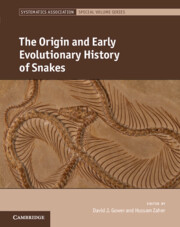Book contents
- The Origin and Early Evolutionary History of Snakes
- The Systematics Association Special Volume Series
- The Origin and Early Evolutionary History of Snakes
- Copyright page
- Dedication
- Contents
- Contributors
- Preface
- 1 Introduction
- Part I The Squamate and Snake Fossil Record
- 2 The Origin and Early Diversification of Squamates
- 3 The First 80 Million Years of Snake Evolution
- 4 The Diversity and Distribution of Palaeogene Snakes
- 5 Miocene Snakes of Eurasia
- Part II Palaeontology and the Marine-Origin Hypothesis
- Part III Genomic Perspectives
- Part IV Neurobiological Perspectives
- Part V Anatomical and Functional Morphological Perspectives
- Index
- Series page
- References
5 - Miocene Snakes of Eurasia
A Review of the Evolution of Snake Communities
from Part I - The Squamate and Snake Fossil Record
Published online by Cambridge University Press: 30 July 2022
- The Origin and Early Evolutionary History of Snakes
- The Systematics Association Special Volume Series
- The Origin and Early Evolutionary History of Snakes
- Copyright page
- Dedication
- Contents
- Contributors
- Preface
- 1 Introduction
- Part I The Squamate and Snake Fossil Record
- 2 The Origin and Early Diversification of Squamates
- 3 The First 80 Million Years of Snake Evolution
- 4 The Diversity and Distribution of Palaeogene Snakes
- 5 Miocene Snakes of Eurasia
- Part II Palaeontology and the Marine-Origin Hypothesis
- Part III Genomic Perspectives
- Part IV Neurobiological Perspectives
- Part V Anatomical and Functional Morphological Perspectives
- Index
- Series page
- References
Summary
Eurasian Miocene snake taxa, localities, stratigraphy, palaeogeography, and palaeoenvironment are reviewed. Palaeogeographic evolution of Paratethys facilitated communication between European and Asiatic faunas since the early Oligocene, with at least two main routes from Asia or Africa into Europe. The early Burdigalian saw spreading of non-erycid Booidea and the first ‘Oriental vipers’ in Europe, which dispersed substantially within Eurasia during late Ottnangian warming. This warm climate, culminating as the Miocene Climatic Optimum, was associated with the middle Burdigalian first appearance of highly thermophilic Naja and Python in Europe. Python disappeared in Europe at the end of the Langhian due to rapid cooling, but Naja and ‘Oriental vipers’ persisted until the late Pliocene and early Pleistocene, respectively. Communication among mid-latitude Asian and European assemblages occurred across the early–middle Miocene, but this Eurasian fauna was heterogeneous, at least since the middle Miocene. Miocene S and SE Asian snakes resemble those of today. Increasing end-Miocene aridity and Eurasia–Africa connection facilitated invasion into Eurasia of African and SW Asian taxa.
Keywords
- Type
- Chapter
- Information
- The Origin and Early Evolutionary History of Snakes , pp. 85 - 110Publisher: Cambridge University PressPrint publication year: 2022
References
- 7
- Cited by

